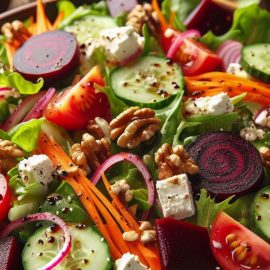

This article is an excerpt from the Shortform book guide to "Bigger Leaner Stronger" by Michael Matthews. Shortform has the world's best summaries and analyses of books you should be reading.
Like this article? Sign up for a free trial here.
Do you know how many calories (and calories for each macro) you should take in each day? What factors should you consider when calculating calories and macros?
In Bigger Leaner Stronger, Michael Matthews recommends flexible dieting. This simply means managing your calorie intake and eating a healthy balance of macronutrients (macros). To do this, you need to know how to calculate calories and macros according to your diet goals.
Continue reading to learn Matthews’s advice for calculating calories and macros.
Calculate Your Daily Calorie Target
Matthews explains how to calculate calories and macros, starting with your daily calorie target and then addressing your target calories for each macronutrient.
Once you know if you want to cut, maintain, or lean bulk and whether to add or subtract calories from your diet, you must figure out the right amount of calories to eat daily. Consider three factors when calculating your target calories: your body recomposition goal, how active you are, and your weight.
Matthews suggests different ranges of calories to target when cutting, maintaining, and gaining. You should aim for the higher or lower end of this range depending on how active you are. If you’re less active, aim for the lower end. If you’re very active, aim for the higher end.
- If you’re cutting: Consume eight to 12 calories per pound of body weight daily. For most, this creates the 20 to 25% calorie deficit necessary to lose weight.
- If you’re maintaining: Consume 12 to 16 calories per pound of body weight daily.
- If you’re lean bulking: Consume 16 to 18 calories per pound of body weight daily. This typically creates the 10% calorie surplus needed for building muscle without gaining too much fat.
| Other Factors Can Affect Your Daily Calorie Target Matthews gives you calorie ranges to aim for based on your activity level, but it’s likely you’ll still have to experiment with your target calories because other factors also affect your daily calorie requirements. These include your sex, height, age, hormones, and medications you’re taking. Men, active people, and younger people tend to need more calories than women, sedentary people, and people who are older. Let’s look at more advice on how much of a calorie surplus or deficit to aim for when cutting, maintaining, and lean bulking. If you’re cutting weight, eating at a deficit of about 500 calories per day should help you cut a pound a week, according to many experts. However, they suggest you aim for a 200 to 300 calorie deficit if you’re more active. When starting your cut, note any symptoms such as fatigue, nausea, headaches, dehydration, constipation, or irritation, which may be a sign that the deficit you started with was too large and that you should adjust your target calorie intake. If you’re maintaining your weight, you can use a simple calorie calculator to quickly determine the number of calories you must eat daily to maintain your current weight. This takes into account your age, height, weight, and sex. If you’re lean bulking, eating a 350 to 500 calorie surplus can promote muscle growth while minimizing fat gain. This should result in a weight gain of around 0.25% to 0.50% of your body weight per week. Increase your target in increments of 100 to 200 calories if you’re not gaining any weight. |
Calculate Your Target Calories for Each Macronutrient
Once you know how many calories you should eat in a day, calculate how many calories you need to allot to each macronutrient (protein, carbs, and fat). The percentages that Matthews recommends are:
- Protein should make up around 30% to 40% of your daily calories. One gram of protein has about four calories.
- Carbs should make up around 30% to 50% of your daily calories. One gram of carbs has about four calories.
- Fats should make up around 20% to 30% of your daily calories. One gram of fat has about nine calories.
These percentages don’t need to add up to 100%—leave up to 20% free for treats (we’ll discuss how to add these to your diet later). To calculate your target calories for each macro, multiply your total daily target by the appropriate percentage in decimal form. For example, 2400 (total daily calorie target) x 0.3 (protein calorie target) is 720 calories of protein daily (or 180 grams).
| Adjust Your Macro Targets Based on Your Body Type If you’re still undecided about what macro ratios work for you, you can factor in your body type to determine them. Some experts argue that different body types benefit from having higher percentages of carbohydrates than others. Determine which of the three main body types fits you the most: ectomorph, mesomorph, or endomorph. People with ectomorph body types tend to be slender and have faster metabolisms. They find it easier to stay lean but harder to gain weight and muscle mass. Nutritionist Sarah Wilkins recommends that ectomorphs eat a higher-carb diet ranging from 30% to 60% of their total calorie intake, depending on their fitness goals. If ectomorphs are trying to gain muscle and weight, they should aim for the higher end of this range and consume at least 25% protein. Mesomorphs are naturally athletic and muscular. They tend to gain muscle and lose fat easily, but gain fat more easily than ectomorphs. Wilkins recommends that people with this body type eat between 20% and 50% of their total calories in carbs. Mesomorphs who are trying to lose fat should eat more fat and protein and fewer carbohydrates. Endomorphs tend to be stockier and have slower metabolisms. They build muscle and fat easily. According to Wilkins, endomorphs should eat no more than 30% to 40% of their total calories in carbs. Endomorphs should aim to eat 25% to 50% protein and 15% to 40% fat. |

———End of Preview———
Like what you just read? Read the rest of the world's best book summary and analysis of Michael Matthews's "Bigger Leaner Stronger" at Shortform.
Here's what you'll find in our full Bigger Leaner Stronger summary:
- How to get the physique you want without trendy diets or brutal workouts
- A simple and scientific approach to nutrition and exercise
- How to plan a workout program based on progressive overload






